Pros
Cons
Introduction
In a shameless attempt to capitalize off a popular gadget, we've decided to review the headphones that come packaged in with the iPhone 3G S. Our official stance on the matter: it's important to have a good baseline to compare other headphones to.
So, how did these things do? Surprisingly well on some tests and laughably poorly on others. While there are definitely some deal breakers involved, the iPhone 3G S headphones aren't entirely terrible. We doubt any audiophiles will put up with them, but they're not so bad mainstream listeners will immediately replace them.
Product Overview
{{section_header}}{{section.name}}{{/section_header}}
The Apple iPhone 3G S headphones look a lot like their old packaged-in headphone offering, but feature a control pendant with a remote, mic, and volume control.
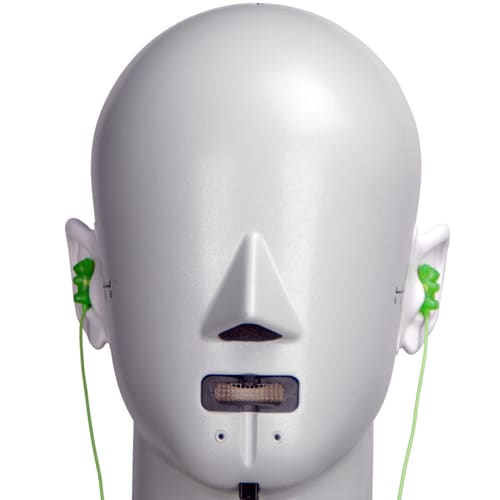
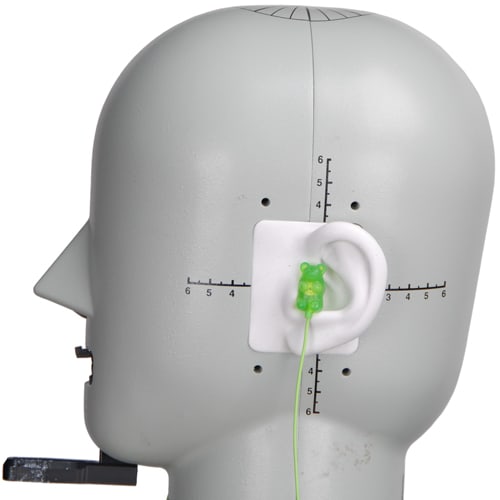
Speakers
{{section_header}}{{section.name}}{{/section_header}}
The ear buds haven't changed much. They're still the kind that sit outside the ear. They don't have sleeves, and their vitals are protected by a mesh screen.
Sides
{{section_header}}{{section.name}}{{/section_header}}
Back
{{section_header}}{{section.name}}{{/section_header}}
Band
{{section_header}}{{section.name}}{{/section_header}}
Cable
{{section_header}}{{section.name}}{{/section_header}}
The headphones have a neck split that's similar to their predecessors. The slider is a bit different, however, as it's only attached to one of the cables. We're guessing this is to improve durability: if your headphones get caught on something and tugged suddenly, the neck split will break its hold. This should prevent the wires inside the cable from getting too jolted. Of course, this is a minor feature.
Additional Features
{{section_header}}{{section.name}}{{/section_header}}
Below are some pictures of the remote and mic. The control pendant will let you perform basic playback functions, such as pausing and skipping between songs. You can also control volume. On the back of the pendant is the mic, which is a teeny-tiny metal circle.
In the Box
{{section_header}}{{section.name}}{{/section_header}}
You know, we thought Shure was the king of pack-ins. Their headphones usually come with a few add-ons and like twelve sleeves. Apple manages to one-up Shure, however, by including an iPhone 3G S with the headphones. To our knowledge, this is the most awesome packaged-in extra we've ever gotten with a pair of headphones.
Durability
{{section_header}}{{section.name}}{{/section_header}}
This new model ups the durability quotient slightly, compared to other packaged-in Apple headphones. The main difference is Apple seems to have gotten wise to their horrible cord guard at the plug. In previous models, there really was no cord guard, which allowed the cable to bend very sharply at the plug. This wreaks havoc on the internal wires, causing wear and tear. These headphones have a slight cord guard. Though it isn't a lot, it's better than nothing.
The issue with these, however, is their sleeveless design. The giant mesh screen covering the front of the ear buds is like a blank canvas for ear grossness. As soon as any sort of grime gets on this thing, it'll be very hard to clean out.
Aesthetics
{{section_header}}{{section.name}}{{/section_header}}
It's hard to be particularly fashionable when your aesthetic is the over-done norm. No one notices in-ear headphones by brand. If they're white, people will assume they're iPod headphones. Even if you have the control pendant swaying around in the open, chances are everyone's curiosity will have been sated by the 'white = iPod' assumption. Therefore, while these aren't ugly by any stretch, they exist solely in the baseline of in-ear aesthetics. These are the headphones we judge other headphones by, for better or worse. Perhaps some company will make a hideous set that becomes more ubiquitous than the Apple headphones. If you are reading this in the future (which you obviously are since this isn't a live stream), and such headphones exist, feel free to bump the aesthetic score by a few points. Chances are, however, the opposite will happen, á la the Motorola Razr: sure, they were trendy for a while, but once they became the norm their unique form factor lost all of its appeal.
Frequency Response
{{section_header}}{{section.name}}{{/section_header}}
The iPhone 3G S headphones have a really decent frequency response. They aren't perfect, but they did a good job of falling within our limits. The bass trails off towards the low end, which might not be desirable. There's also a bit of a fall off after the 7kHz line, followed by a bit of a spike at 10kHz.
In general, the response was even. We had no real complaints here.
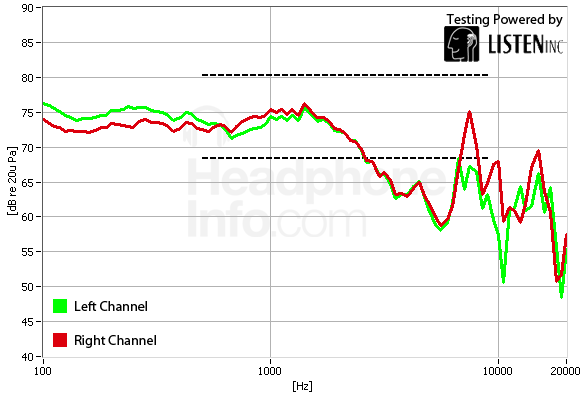
Click here for more information on our frequency response test.
Distortion
{{section_header}}{{section.name}}{{/section_header}}
As you may or may not have guessed by the score or the graph to the right, the iPhone 3G S' headphones aren't the best in terms of distortion. In fact, they're pretty bad.
The reason for this low-end distortion is likely due to the headphones' design. Since they sit outside the ear canal, there's no seal between the headphones and your ear. Therefore, instead of pumping bass directly into your ear, it shotguns it in the right direction. Bassy sounds are hard for in-ears create, since they involve moving a lot of air and in-ears don't have a lot of room for large, fancy drivers.
We also noticed there was a lot of noise when we hooked it up to an amp.
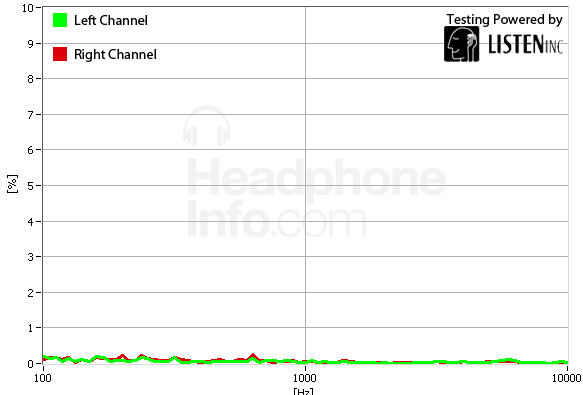
Click here for more information on our frequency response test.
Tracking
{{section_header}}{{section.name}}{{/section_header}}
Once we finally got the ear buds to stay in place, we found the headphones' tracking was actually really good.
You may notice that the headphones seem to be heavy in the right channel. This is true, but it's by a barely audible amount. The things people tend to notice are sudden shifts in volume from one channel to another.
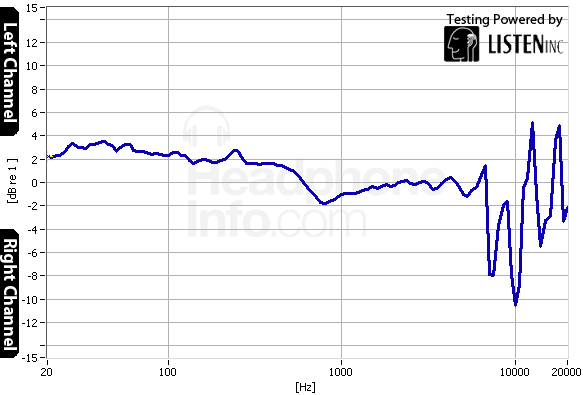
Click here for more information on our frequency response test.
Isolation
{{section_header}}{{section.name}}{{/section_header}}
Yowza. This result isn't really unexpected, but it's still a pretty dismal sight. If you're looking for isolation, you should maybe check out headphones that either cover your ears or fit inside them. These just kinda chill on the outside.
The only way you're going to block out external noise with these things is by brute force: pumping the volume up to ridiculous levels.
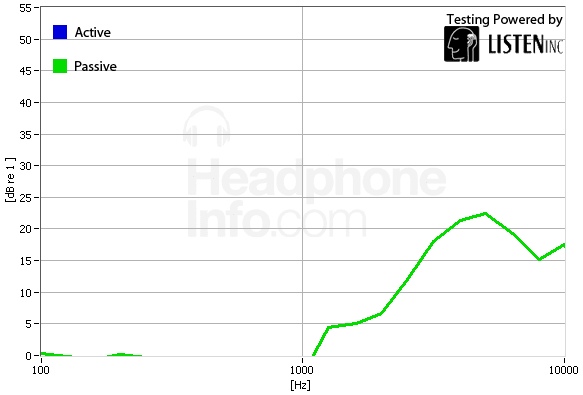
Click here for more information on our isolation test.
Leakage
{{section_header}}{{section.name}}{{/section_header}}
Although the headphones did well here, this test is conducted in a silent room with moderate playback. If you're wearing these things on a bus or train, you're going to have to increase the volume like crazy in order to overpower it. If you do this, the headphones will leak.
If you've ever heard someone in the subway listening to their music and thought, 'Jeepers, that youth is likely harming his hearing with such loud playback!' keep this in mind. Chances are that chap doesn't notice, and is just trying to drown out the ambient squeals.
Of course, this leads to potentially embarrassing situations. Say the one Gloria Estefan song in your playlist comes on. Now, since you're on a bus or train, the vehicle's locomotion is creating so much racket that it's drowning out Gloria's smooth alto voice. So you turn up the volume. Now everyone around you thinks you're such a devoted Este-fan that you are actually trying to use sheer decibel force to shake your body when you do that conga, at the risk of deafening yourself. For most people, this will be a suboptimal outcome.
Click here for more information on our leakage test.
Maximum Usable Volume
{{section_header}}{{section.name}}{{/section_header}}
The iPhone 3G S headphones were capable of outputting 112.82dB before they hit a bad overall distortion level. This might seem like a bit of an inconsistency given our distortion test result, but we're looking at overall distortion in this instance, and the headphones were pretty distortion free after 1kHz. It looks like they will hold up pretty well.
While we were testing particularly loud sounds, the headphones started rattling around. To use an accurate, but not particularly witty simile, it sounded like someone shaking a ball bearing around in a plastic cup. We would not recommend playing back music at a loud volume if you wish to protect your $0 investment.
Click here for more on our maximum usable volume test
Short-Term Use
{{section_header}}{{section.name}}{{/section_header}}
The iPhone 3G S' headphones aren't particularly comfortable or uncomfortable. They sit on the outside of your ears, so they get around the issue most people have with inserting foreign objects into their ear canal. If you are someone who's used to canal headphones, however, these will leave you with a vague sense of unease. For us, they always felt like they were falling out.
As always, this is just our opinion. We don't have a robot that can test comfort and, even if we somehow did, we doubt everyone would agree with the robot's standards.

Extended Use
{{section_header}}{{section.name}}{{/section_header}}
Since the headphones don't protrude into the ear and aren't particularly heavy, there's really nothing that would inspire change over the course of a 6-hour period.
Customizability
{{section_header}}{{section.name}}{{/section_header}}
These headphones don't really have much in the way of customization. They don't come with sleeves. They do have one of those neck split adjusters, for those that like the cord to follow the contour of their chin. The neck split adjuster can also detach if the left and right cables get pulled apart. This will help increase durability if you violently remove your headphones.
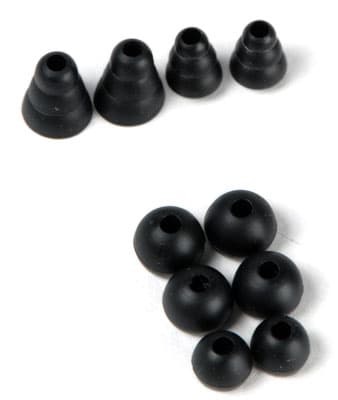
Cable Connectivity
{{section_header}}{{section.name}}{{/section_header}}
The iPhone 3G S' cord is 3 feet, 6.5 inches inches long. This is an average length for a set of in-ear headphones. It's short enough to not create a lot of slack when it's attached to a media player in your pocket.
If you want to connect to a stereo system or something, these headphones aren't really long enough to be feasible.
Portability
{{section_header}}{{section.name}}{{/section_header}}
These headphones are quite portable, quite possibly because they're meant for use with an iPhone 3G S, a portable electronic device. The cord is relatively short and in-ear headphones aren't particularly big. You shouldn't have any problems carting these around.
Maintenance
{{section_header}}{{section.name}}{{/section_header}}
There really isn't much you can do to help maintain your iPhone 3G S headphones. They don't really disassemble, and there's no sleeves to change out. They have a grid covering their front end that's fairly hard to clean. It can be removed, but the internal wires are attached. This means you can't really replace it unless you have a set of spares and a soldering iron.
Other Features
{{section_header}}{{section.name}}{{/section_header}}
Battery
These headphones don't require any batteries. Batteries are a pain to keep track of, so we award points to any headphones that don't require any.
Remote & Mic
These headphones have a remote and a mic, which will let you take phone calls or perform basic media playback controls.
Volume Control
There's a volume control on the headphones' pendant. It will let you control volume. That's about it.
Design
{{section_header}}{{section.name}}{{/section_header}}
Both headphones are really similar. They're both white and gray, meaning anyone who sees you with them will assume 'iPod' and lose interest.
In terms of design, the iPhone 3G S headphones has some durability improvements in their superior cord guards, but the sold-separately model comes with sleeves. This helps prevent ear garbage from sullying your headphones' internals. Also, if they're not comfortable you can swap them out for smaller/larger ones.
Frequency Response
{{section_header}}{{section.name}}{{/section_header}}
Interestingly enough, the free Apple headphones offer a comparable frequency response. It's better on paper, but doesn't have the bass that the sold-separately headphones have.
Distortion
{{section_header}}{{section.name}}{{/section_header}}
Although the auxiliary headphones have some small issues with distortion towards the high end, their freebie brothers have quite a lot of low end distortion.
Tracking
{{section_header}}{{section.name}}{{/section_header}}
The supplemental Apple headphones have a very even tracking, but the iPhone 3G S' included headphones also have great tracking. As it turns out, the replacement model is slightly more balanced, but the differences between these two isn't really perceptible.
Isolation
{{section_header}}{{section.name}}{{/section_header}}
This isn't really a contest. The ones that fit into your ears block out sound. The iPhone 3G S headphones, conversely, stand outside your ears like inept guards, letting all external noise sneak past.
Comfort
{{section_header}}{{section.name}}{{/section_header}}
Our issue with Apple headphones continually manifests itself, regardless of the iteration. The things just don't stay in well. Our issue with the replacements is that they pull free if you run the cable under your shirt. Also, in a lot of people around the office, they'd just pop out after a while, even when the wearer was just sitting still.
The packed-in headphones won't outright pop out as easily, but that's mainly because they're never inside your ears to begin with. They balance on your tragus and antitragus, which will drive in-canal headphone users crazy.
If we had to pick the most comfortable one, we'd have the pick the iPhone 3G S headphones, simply because they stay in place more consistently.
Verdict
{{section_header}}{{section.name}}{{/section_header}}
The freebie headphones really aren't so terrible compared to their replacements. If you want an upgrade from the packaged-in headphones, these Apple replacements aren't a bad idea. They aren't the best idea either, however, because the Apple replacement headphones aren't the best in-ears. If you want a great set of headphones with a built-in remote and mic, read the following comparison section.
Design
{{section_header}}{{section.name}}{{/section_header}}
The iPhone headphones don't have a bad design per se, but they're so ubiquitous now that they've lost their novelty. The MM 50 iPs are nice looking, but not striking in any particular way. Really, in-ears aren't going to win you over with aesthetics.
In terms of durability, the MM 50 iPs do slightly better in most areas. Their plug is a danger zone, so be sure to treat it with care. Otherwise though, the MM 50 iPs are a more solid option.
Frequency Response
{{section_header}}{{section.name}}{{/section_header}}
The iPhone 3G S headphones did well here. They actually have a better frequency response than the MM 50 iPs, which tend to bounce around a bit and boost bass slightly more than they should. If you love bass, then the MM 50 iPs will be happy to recreate some loud low frequencies. If you want a more even keel to your playback, the iPhone 3G S is better.
Distortion
{{section_header}}{{section.name}}{{/section_header}}
The write-ups for the distortion and isolation sections on all these comparisons are going to be brief: the iPhone 3G S doesn't do either particularly well.
Tracking
{{section_header}}{{section.name}}{{/section_header}}
Despite appearances of the charts, the iPhone 3G S headphones also beat the MM 50 iPs in terms of tracking. This is probably due to a micro-spike somewhere on the graph that the normalized display doesn't show.
Isolation
{{section_header}}{{section.name}}{{/section_header}}
There is a clear winner and loser here. If you want isolation, the iPhone 3G S headphones aren't for you.
Comfort
{{section_header}}{{section.name}}{{/section_header}}
The MM 50 iPs are hands down more comfortable. When they're in, they stay in well. The sleeves are also soft, so they don't exert a lot of pressure on the insides of your ears.
Verdict
{{section_header}}{{section.name}}{{/section_header}}
If you want to upgrade your packaged-in headphones, the MM 50 iPs are a great option. Sure, they don't have the best audio quality in the market, but they're far better than their low price would indicate. This upgrade is also great because the MM 50 iPs have a remote and mic like the Apple headphones. The one feature you'll be losing is the volume controls.
Design
{{section_header}}{{section.name}}{{/section_header}}
Again, in-ears don't have a lot of surface area to dedicate to aesthetics. The difference between these two headphones will likely be their color.
In terms of durability, the AH-C351s have the upper hand. They have better cord guards, and are protected by sleeves.
Frequency Response
{{section_header}}{{section.name}}{{/section_header}}
The Apple headphones have a more even frequency response. The AH-C351s have better bass, drop out between 2kHz and 7kHz, then become erratic up until they peter out.
Distortion
{{section_header}}{{section.name}}{{/section_header}}
Though the AH-C351s has some minor distortion issues, they pale in comparison to the iPhone 3G S's results.
Tracking
{{section_header}}{{section.name}}{{/section_header}}
The iPhone 3G S's tracking results were a bit better than the AH-C351s', though both headphones did well on this test.
Isolation
{{section_header}}{{section.name}}{{/section_header}}
The AH-C351s had average isolation for a set of in-ear headphones. The iPhone 3G S had average isolation for a set of totally uncovered ears.
Comfort
{{section_header}}{{section.name}}{{/section_header}}
The Denon AH-C351s have very thin, soft sleeves. They're pretty comfortable. A lot of people will likely think the iPhone 3G S headphones are comfortable as well, but for anyone used to a set of canal in-ears will be constantly irked by the sensation that their headphones are falling out.
Verdict
{{section_header}}{{section.name}}{{/section_header}}
The Denon AH-C351s might not be the best upgrade for the iPhone 3G S headphones. For starters, it doesn't have a remote, mic, or volume controls. The iPhone headphones offer similar audio quality, but have inferior isolation. If you take a train or bus to work in the morning, the AH-C351s might be a good upgrade, but even then you'll be sacrificing a few extras.
Design
{{section_header}}{{section.name}}{{/section_header}}
The Shure SE115s have a slightly strange design to them. They're intended to be used with the cord extending from the top of the ear bud. This means you'll have to wrap the cord around the back of your ears. The SE115s also have a modular cord, meaning the headphones are about a foot long, then come with an extension. This lets users add in-line accessories.
The SE115s are also significantly more durable.
Frequency Response
{{section_header}}{{section.name}}{{/section_header}}
The built-in headphones have a more stable frequency response than the SE115s.
Distortion
{{section_header}}{{section.name}}{{/section_header}}
This isn't really a contest.
Tracking
{{section_header}}{{section.name}}{{/section_header}}
Both headphones had good tracking, but the iPhone 3G S' results were a bit better than the SE115's.
Isolation
{{section_header}}{{section.name}}{{/section_header}}
The iPhone 3G S headphones have terrible isolation. The SE115s lie on the opposite end of the spectrum.
Comfort
{{section_header}}{{section.name}}{{/section_header}}
This comparison comes down to what you're used to, because the two headphones will be really annoying to those who aren't used to the style. Those who are used to Apple in-ears that just kinda sit outside the ear will likely hate the SE115s, whose foam sleeves can feel like they're flooding your ear, creating a bit of pressure. Those used to canal in-ears will hate how the iPhone 3G S headphones feel like they're falling out.
Verdict
{{section_header}}{{section.name}}{{/section_header}}
The SE115s are solid headphones, but seem a bit overpriced compared to the iPhone 3G S pack-ins. The iPhone headphones come with an in-line remote, mic, and volume control. The SE115 can accept add-ons that provide this functionality, but they'll be separate purchases.
If you want isolation, however, the SE115s soundly trounce the iPhone 3G S headphones. Also, if you care more about distortion than a solid frequency response, the SE115s win.
Conclusion
{{section_header}}{{section.name}}{{/section_header}}
Surprisingly, although the Apple iPhone 3G S headphones are a toss-in with some kind of fancy phone, they're not entirely terrible. Sure, they have some significant issues with distortion in the low end, but this is likely due to their 'we sit outside the ear, not in it' design. We noticed that the headphones also seemed to sound a bit noisy when connected to an amp.
For a set of packaged-in headphones, they're not terrible. In fact, they compare well, score-wise, with some headphones we recommend. Their main issues are with distortion and isolation. Both of these issues are noticeable, and will likely be a deal breaker for a lot of people. Further, the headphones themselves sound flat, but since this is a subjective quality we couldn't test for it.
Although these headphones aren't as bad as some other packaged-in headphones, we'd still recommend replacing them. According to tests we've run on our sister site, MediaPlayerInfo.com, the iPods and iPhones of the world offer great audio output. These headphones and their terrible low-end distortion simply won't do your fancy new iPhone justice. We'd recommend the perennial favorite, the Sennheiser MM 50 iPs, which have similar functionality and far superior audio quality. If you want to keep the all-white aesthetic, you could upgrade to the Apple In-ear Headphones with Remote and Mic, but the only real advantages you pick up here are slightly less distortion and better isolation.
Meet the tester
Mark Brezinski works on the Home Team, reviewing refrigerators, minifridges, dishwashers, washing machines, dryers, air conditioners, air purifiers, and fans.
Checking our work.
Our team is here to help you buy the best stuff and love what you own. Our writers, editors, and experts obsess over the products we cover to make sure you're confident and satisfied. Have a different opinion about something we recommend? Email us and we'll compare notes.
Shoot us an email